EVALUATE POLYNOMIALS USING SYNTHETIC DIVISION
Subscribe to our ▶️ YouTube channel 🔴 for the latest videos, updates, and tips.
An elegant way of dividing a polynomial by a linear polynomial was introduced by Paolo Ruffin in 1809. His method is known as synthetic division. It facilitates the division of a polynomial by a linear polynomial with the help of the coefficients involved.
Let us see how synthetic division can be used to explain the method of synthetic division with an example.
Let p(x) = x3 + 2x2 - x - 4 be the dividend and q(x) = x + 2 be the divisor. We shall find the quotient s(x) and the remainder r, by proceeding as follows.
Step 1 :
Arrange the dividend and the divisor according to the descending powers of x and then write the coefficients of dividend in the first row (see figure). Insert 0 for missing terms.

Step 2 :
Find out the zero of the divisor.
x + 2 = 0
x = -2
Step 2 :
Put 0 for the first entry in the 2nd row.
Complete the entries of the 2nd row and 3rd row as shown below.
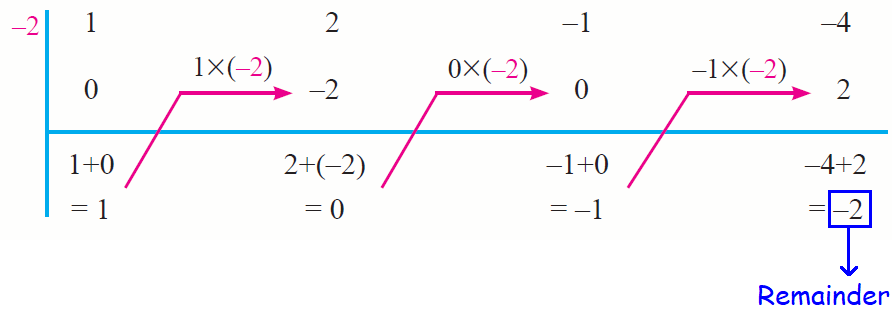
Step 4 :
Write down the quotient and the remainder accordingly. All the entries except the last one in the third row constitute the coefficients of the quotient.
Thus, the quotient is x2 - 1 and the remainder is –2.
In the above synthetic division. zero of the divisor is -2 and the remainder is -2.
This can be written as
p(-2) = -2
When we substitute the zero of the divisor -2 for x into p(x), the result is the remainder -2.
That is, evaluation of the polynomial p(x) for x = -2 is -2.
Example 1 :
If f(x) = x3 + x2 - 7x - 3, then evaluate f(3).
Solution :

From the synthetic division above, we have
f(3) = 12
Example 2 :
If g(x) = 2x3 - 3x2 - 3x + 2, then evaluate g(-1).
Solution :

From the synthetic division above, we have
g(-1) = 0
Example 3 :
If p(x) = x3 - 3x2 - 10x + 24, then evaluate p(2).
Solution :

From the synthetic division above, we have
p(2) = 0
Example 4 :
If q(x) = 2x4 + x3 - 14x2 - 19x + 6, then evaluate q(-1/2).
Solution :

From the synthetic division above, we have
q(-1/2) = 12
Write the function in the form f(x) = (x - k) q(x) + r for the given value of k, the demonstrate that f(k) = r.
Example 5 :
Given function is
f(x) = x3 - x2 - 14x + 11
value of k is 4
Solution :
f(x) = (x - 4) q(x) + r
Dividing the polynomial by 4, we get
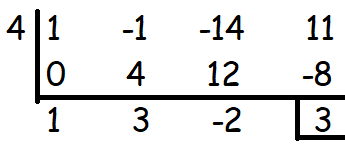
(x - 4)(x2 + 3x - 2) + 3
Quotient = x2 + 3x - 2 and
remainder = 3
Example 6 :
What is the value of k such that
(x3 − x2 + kx − 30) ÷ (x − 5) has a remainder of zero?
a) -14 b) -2 c) 26 d) 32
Solution :
(x3 − x2 + kx − 30) ÷ (x − 5)
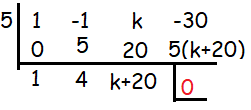
The reaminder should be 0 when the given polynomial is divisible by the linear factor x - 5.
-30 + 5(k + 20) = 0
5(k + 20) = 30
k + 20 = 30/5
k + 20 = 6
k = 6 - 20
k = -14
So, the value of k is -14.
Example 7 :
The graph represents the polynomial function
f(x) = x3 + 3x2 − x − 3
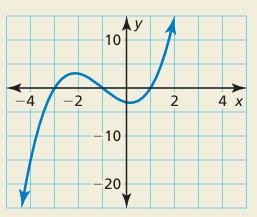
a. The expression f(x) ÷ (x − k) has a remainder of −15. What is the value of k?
b. Use the graph to compare the remainders of
(x3 + 3x2 − x − 3) ÷ (x + 3) and (x3 + 3x2 − x − 3) ÷ (x + 1)
Solution :
a) By observing the graph, we know that one of the points is (-4, -15). So, dividing the polynomial by -4, we get the remainder as -15. Comparing with x - k and x - 4, the value of k is 4.
b)
|
x + 3 = 0 x = -3 |
x + 1 = 0 x = -1 |
Observing the graph, -3 and -1 are the x-intercepts. The output is 0. So, the remainders of dividing the given polynomials by (x + 3) and (x + 1), we get the remainder as 0.
Example 8 :
The volume V of the rectangular prism is given by
V = 2x3 + 17x2 + 46x + 40
Find an expression for the missing dimension
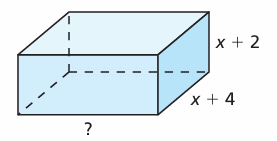
Solution :
V = 2x3 + 17x2 + 46x + 40
Volume of rectangular prism = length x width x height
By observing the figure above,
length = ?
width = x + 4 and
height = x + 2
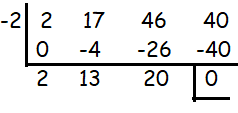
Dividing the cubic polynomial by the linear factor x + 2, we get
2x2 + 13x + 20 as quotient and 0 as remainder.
= 2x2 + 13x + 20
= 2x2 + 8x + 5x + 20
= 2x(x + 4) + 5(x + 4)
= (2x + 5)(x + 4)
So, the length of the rectangular prism is 2x + 5.
Subscribe to our ▶️ YouTube channel 🔴 for the latest videos, updates, and tips.
Kindly mail your feedback to v4formath@gmail.com
We always appreciate your feedback.
About Us | Contact Us | Privacy Policy
©All rights reserved. onlinemath4all.com
Recent Articles
-
Specifying Units of Measure
Dec 15, 25 07:09 PM
Specifying Units of Measure -
Quantitative Reasoning Questions and Answers
Dec 14, 25 06:42 AM
Quantitative Reasoning Questions and Answers -
Coin Tossing Probability
Dec 13, 25 10:11 AM
Coin Tossing Probability - Concept - Sample Space - Formula - Solved Problems